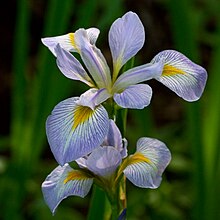bio.wikisort.org - Plant
Iris virginica, with the common name Virginia iris, is a perennial species of flowering plant, native to eastern North America.
| Iris virginica | |
|---|---|
 | |
| Scientific classification | |
| Kingdom: | Plantae |
| Clade: | Tracheophytes |
| Clade: | Angiosperms |
| Clade: | Monocots |
| Order: | Asparagales |
| Family: | Iridaceae |
| Genus: | Iris |
| Subgenus: | Iris subg. Limniris |
| Section: | Iris sect. Limniris |
| Series: | Iris ser. Laevigatae |
| Species: | I. virginica |
| Binomial name | |
| Iris virginica | |
| Synonyms[1] | |
| |
It is common along the coastal plain from Florida to Georgia in the Southeastern United States.[2]
It was identified as a separate species by Edgar Anderson, and is one of the three Iris species in Anderson's Iris flower data set, used by Ronald Fisher in his 1936 paper "The use of multiple measurements in taxonomic problems" as an example of linear discriminant analysis.[3][4]
Description
Iris virginica is a perennial plant. The plant has 2 to 4 erect or arching, bright green, lance-shaped leaves that are flattened into one plane at the base. Leaves are 1–3 cm (1⁄2–1+1⁄4 in) wide and are sometimes longer than the flower stalk. The fleshy roots (1–2 cm or 1⁄2–3⁄4 in in diameter) are rhizomes that spread underground. Pale brown, variably shaped seeds are born in three-part fruit capsules (3–6 cm or 1+1⁄4–2+1⁄4 in long, 1–2 cm or 1⁄2–3⁄4 in wide).[5]
The slightly fragrant flowers (4 cm or 1+1⁄2 in long, 7 cm or 2+3⁄4 in across) consist of 3 horizontal sepals, or "falls", and 3 erect petals. The petals and sepals can vary in color from dark-violet to pinkish-white. The sepals have a splash of yellow to yellow-orange at the crest. Each plant has 2 to 6 flowers that bloom from April to May upon a single, erect, 30–90 cm (12–35 in) tall stalk. The stalk is sometimes branched and has a slight zigzag appearance.[5]
Uses
The Cherokee use this medicinal plant for traditional medicinal uses. The root is pounded into a paste that is used as a salve for the skin. An infusion made from the root is used to treat ailments of the liver, and a decoction of the root is used to treat "yellowish urine".[6][7]
It may be one of the Iris species used by the Seminole to treat "shock following alligator-bite".[2]
References
- "Iris virginica". World Checklist of Selected Plant Families (WCSP). Royal Botanic Gardens, Kew. Retrieved 13 April 2015 – via The Plant List.
- USDA, NRCS (n.d.). "Iris virginica". The PLANTS Database (plants.usda.gov). Greensboro, North Carolina: National Plant Data Team.
- R. A. Fisher (1936). "The use of multiple measurements in taxonomic problems" (PDF). Annals of Eugenics. 7 (2): 179–188. doi:10.1111/j.1469-1809.1936.tb02137.x. hdl:2440/15227.
- Kleinman, Kim (1999). "His Own Synthesis: Corn, Edgar Anderson, and Evolutionary Theory in the 1940s". Journal of the History of Biology. 32 (2): 293–320. ISSN 0022-5010. Retrieved 15 February 2022.
- Missouri Botanical Garden: Iris virginica[permanent dead link]
- The University of Michigan at Dearborn: Native American Ethnobotany of Iris virginica
- Hamel, Paul B. and Mary U. Chiltoskey 1975 Cherokee Plants and Their Uses -- A 400 Year History. Sylva, N.C. Herald Publishing Co. (p. 41)
External links
На других языках
- [en] Iris virginica
[es] Iris virginica
Iris virginica, con el nombre común de iris de Virginia, es una especie perenne de planta con flores, nativa del este de América del Norte.[ru] Ирис виргинский
Ирис виргинский (лат. Iris virginica) — вид травянистых растений рода Ирис (Iris) семейства Ирисовые (Iridaceae).Другой контент может иметь иную лицензию. Перед использованием материалов сайта WikiSort.org внимательно изучите правила лицензирования конкретных элементов наполнения сайта.
WikiSort.org - проект по пересортировке и дополнению контента Википедии